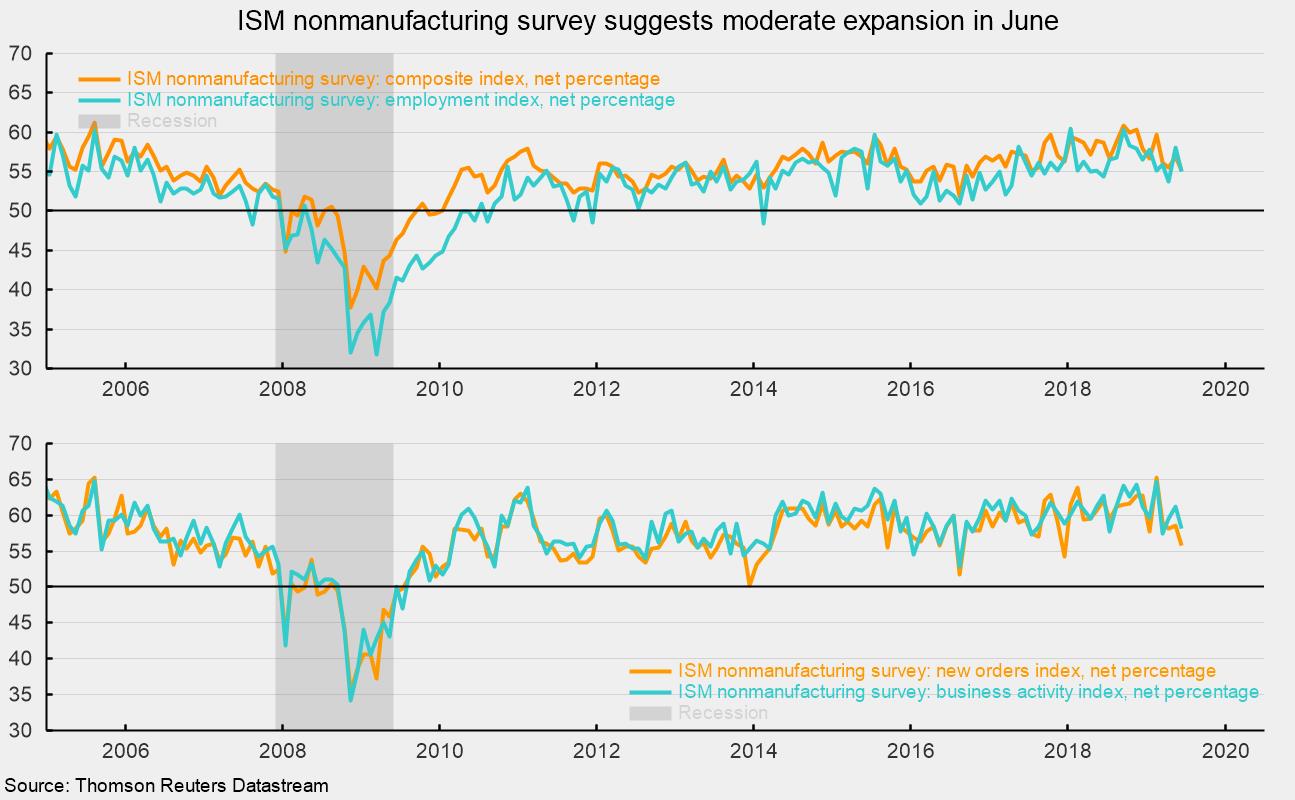Slow Growth Continues as Expansion Sets Record
The Institute for Supply Management’s (ISM) nonmanufacturing index pulled back to 55.1 percent in June from 56.9 in May (see top chart). For this index, 50 is neutral, with readings above 50 suggesting expansion and readings below 50 suggesting contraction. Typically, the index ranges between 50 and 60, with dips below 50 during recessions. Historically, readings above 48.6 percent have suggested expansion of the overall economy. The June result is the 113th consecutive reading above 50 percent and the 119th month above 48.6 percent.
Among the key components of the index, the business-activity index (equivalent to the production index in the ISM manufacturing report) was 58.2 percent in June, making June the 119th consecutive month above 50 (see bottom chart). In June, 15 industries in the nonmanufacturing survey reported growth while just 1 reported a decrease in activity.
The nonmanufacturing new-orders index came in at 55.8 percent, down from 58.6 in May. June was the 119th month of readings above 50 (see bottom chart). The new-export-orders index, a separate index that measures only orders for export, was 55.5 percent in June, unchanged from May, and has been above 50 for 29 consecutive months.
The nonmanufacturing employment index decreased to 55.0 in June, versus 58.1 in May, and has been expanding for 64 consecutive months. Nine industries reported expanding employment in June while five reported contraction.
Supplier deliveries, a measure of delivery times for suppliers to non-manufacturers, came in at 51.5, up from 49.5 in May. It suggests suppliers are falling farther behind in delivering supplies to non-manufacturers.
Prices for input materials and services rose for the 25th month as the price index rose to a reading of 58.9 in June versus 55.4 in May. The index had been running above 60 from late 2017 through late 2018 before easing back in the last few months. Tariffs complicate the outlook for input-cost pressures and, in conjunction with a tight labor market and rising wages, suggest the potential for significant pressure on profit margins.
The results from both the ISM manufacturing report and the nonmanufacturing report are consistent with the estimate of private payroll employment from ADP. ADP estimates that the private sector added 102,000 new employees in June. That gain is below the roughly 190,000 average monthly gain reported by the Bureau of Labor Statistics over the 12 months through May but still solidly in positive territory. Additional support for a mildly positive outlook comes from the report on weekly initial claims for unemployment insurance, which shows a seasonally adjusted 221,000 new claims for the week ended June 29. That is down 8,000 from the prior week. The four-week average came in at 222,250, up 500 from the prior four-week average. Over the last 18 months, initial claims have averaged around 220,000, a very low figure by historical comparison.
Sales of light vehicles totaled 17.3 million at an annual rate in June, down from a 17.4 million pace in May. The pace of sales in June remains above the midpoint of the 16 to 18 million-unit range that we have seen for much of the past two decades. Unit vehicle sales fell significantly below the range as the 2008–9 recession began, hitting a low of just 9.0 million in February 2009. Sales began a slow recovery, returned to the 16 to 18 million range in March 2014, and have remained there since.
As of June 2019, light-truck sales totaled 12.3 million at an annual rate while cars managed just 5.0 million. That puts the light-truck share at 71.3 percent, completely dominating the car share of 28.7 percent. The rising share of light trucks continues a trend in place since 2013. In February 2013, the split between cars and light trucks (SUVs and pick-up trucks) was about even, with both segments selling about 7.76 million at an annual rate.
Orders for manufactured goods at the nation’s factories fell 0.7 percent in May. Within the total, new orders for durable goods decreased 1.3 percent in May, led by large declines in defense and nondefense aircraft orders. Year to date, total orders are up just 0.9 percent to $2,464 billion with durable goods rising 1.0 percent to $1,236 billion and nondurable goods rising 0.9 percent to $1,228 billion.
Within the report on new factory orders are data on new orders for capital equipment, or business investment. This subcategory is particularly important for two reasons. First, business investment can have a major impact on future productivity trends, and productivity is critical for helping offset cost increases as well as raising living standards over the long term. Second, capital-goods orders tend to be early indicators of turns in the business cycle. Real new orders for core capital goods — that is, real nondefense capital goods excluding aircraft — is one of the indicators in AIER’s Leading Indicators index. On a nominal basis, new orders for core capital goods rose 0.5 percent in May. Year to date, core-capital-goods orders are up 2.3 percent to $341.8 billion versus $334.3 billion for the first five months of 2018.
Overall, a variety of data released today suggest continued economic expansion. If the economy posts growth in July, as seems likely, the current expansion will set a record for longevity at 121 consecutive months. Concerns over trade policy, escalating trade wars, and global economic growth may be starting to impact both consumers’ and business leaders’ confidence, putting consumer spending and investment plans at risk. While uncertainty regarding the outlook is significant, the outlook is cautiously positive.






